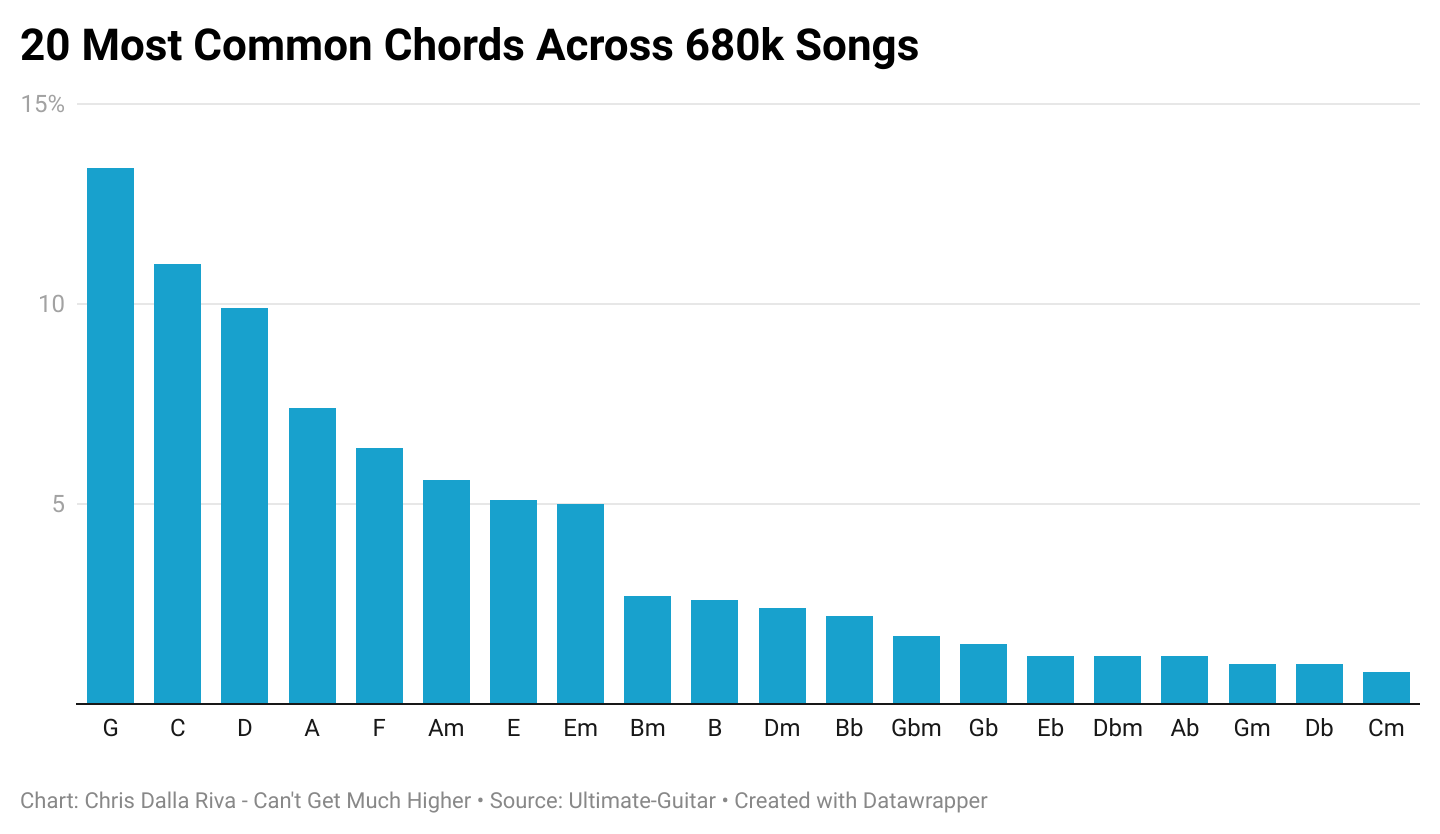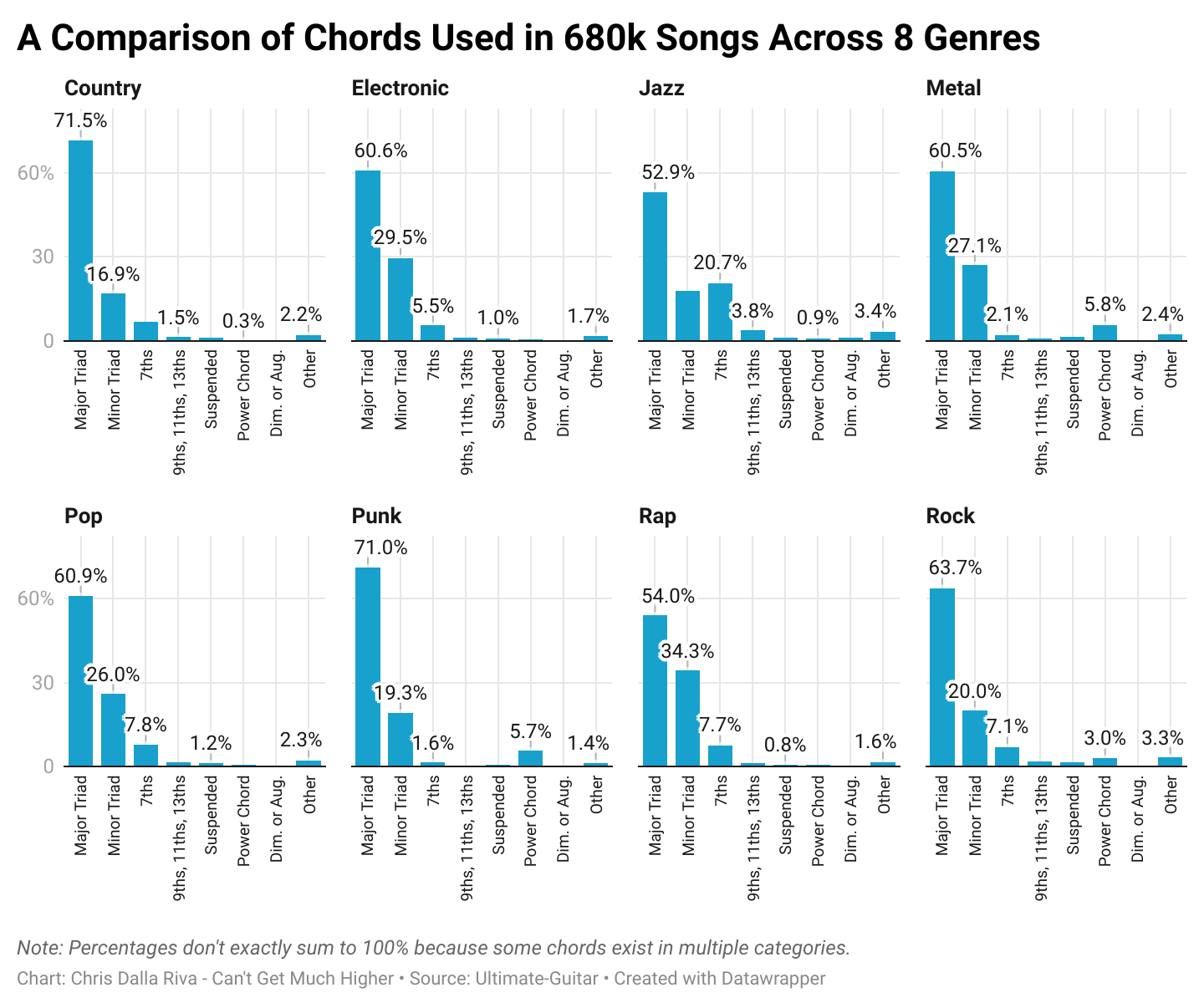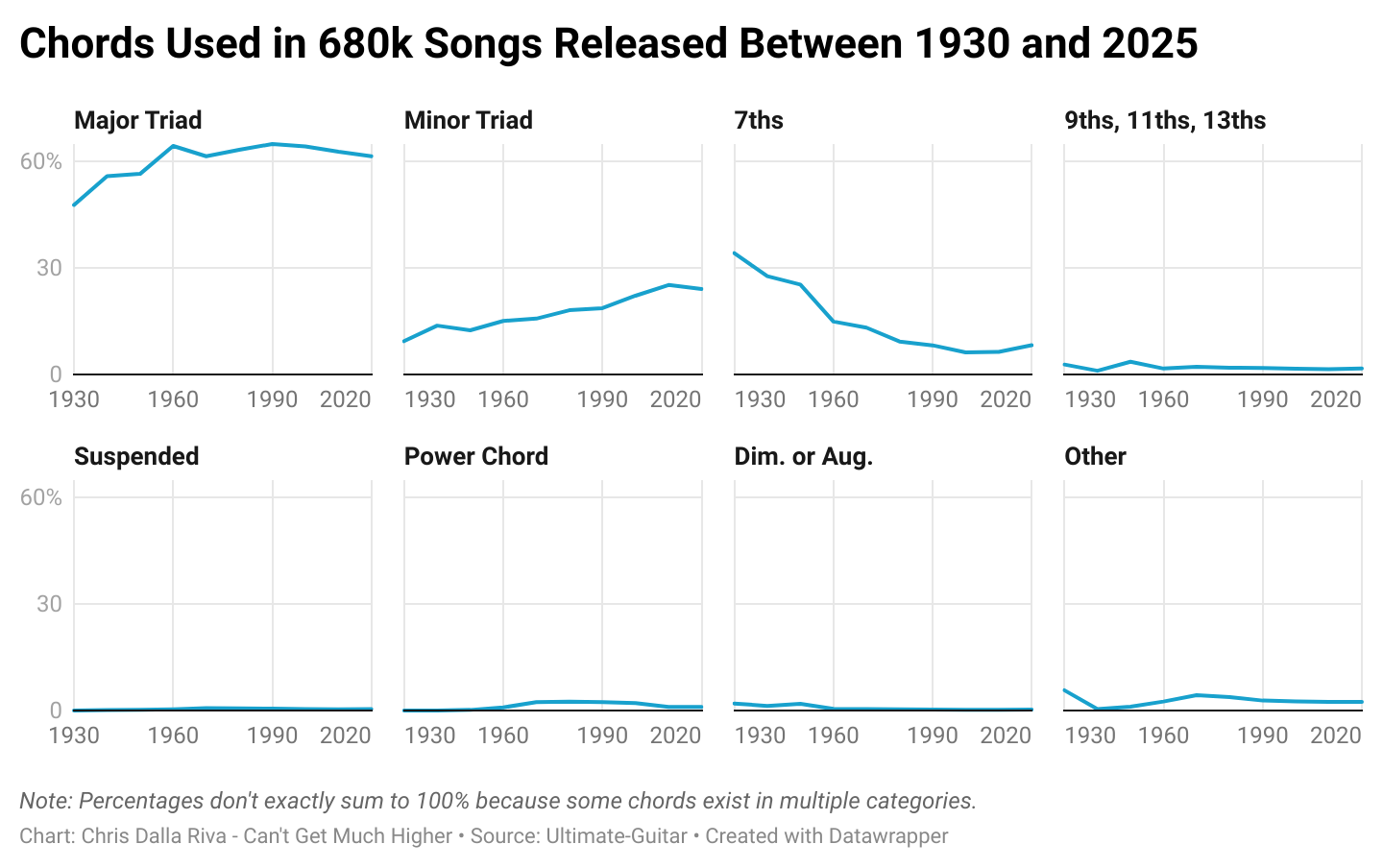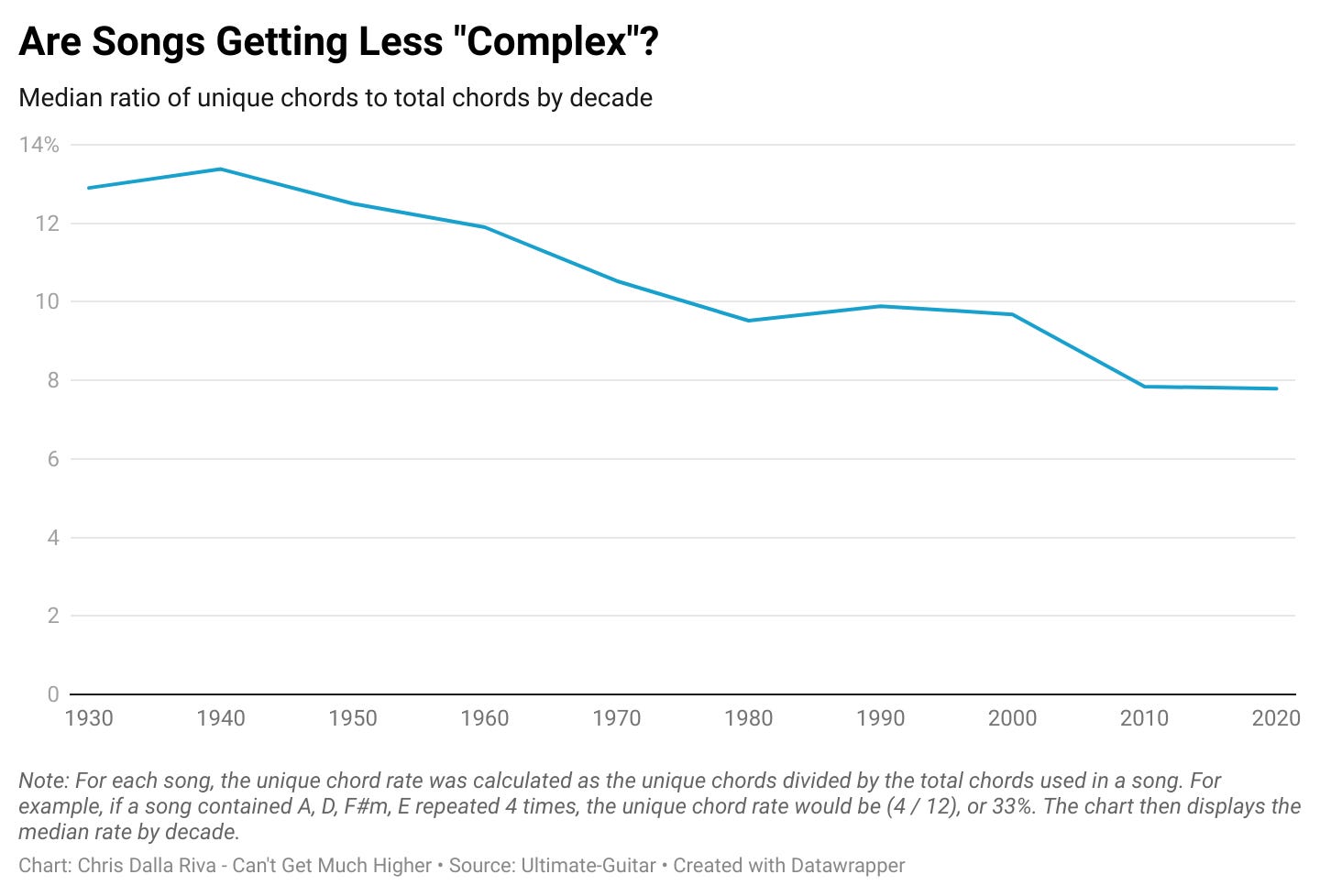Welcome back to Can’t Get Much Higher, where music and data meet. Before we get into this week’s topic, here are some recent pieces that people have enjoyed:
Now, onto a big dataset about chords.
By Chris Dalla Riva
Chordonomicon. I couldn’t get the word out of my head. Every syllable was just as beautiful as the last. Try saying it. Kord-oh-nom-i-con. It sounds like a mystical word. And, for me, it is. But it’s a term that didn’t exist last year.
“Chordonomicon” was coined by 5 researches last October when they needed a name for a new project that they’d just completed. This project pulled together chord progressions and genres for nearly 680,000 songs from the popular music learning website Ultimate-Guitar. I knew I had to do something with the data. But what?
Typically, when I write a data-driven piece for this newsletter, my approach is somewhat scientific. First, I have a hypothesis, like “there has been an increase in music biopics over the last few years.” Then I find some data to test that hypothesis. Whether I’m correct or not, I publish the results. For example, when I looked at music biopics, I found that on an absolute basis there was a dramatic increase over the last few years, but on a relative basis, the peak was in the 1940s.
I didn’t really have a hypothesis to test with the Chordonomicon dataset, though. I just wanted to explore what was in there. There had to be something interesting among 680,000 chord progressions. And there was. But, first, we should start with a simple question: What’s a chord?
If you’re looking for in depth discussions on music theory, I’m not your guy. (You should probably turn to someone like
and his newsletter Ethan teaches you music.) But for this case, I think some basic definitions will help. A “note” is a single pitch. When you hit one key on the piano, for example, you are playing a note. An “interval” is a combination of two notes. A “chord” is a combination of three or more unique notes (e.g., a C major chord is comprised of the notes C, E, and G).Above you can see a breakdown of the top 20 most common chords across the nearly 52 million chords notated in the Chordonomicon dataset. If you’ve ever played a guitar or piano, you won’t be surprised by the fact that G major and C major are at the top, accounting for 24% of all chords. These are some of the first chords you learn on those instruments. What’s interesting is that chord choices differ when you look across genre.
Below you can see a usage comparison of 20 common chords in jazz and country. The differences are stark. In country, for example, five major chords — G major, C major, D major, A major, and F major — comprise 61% of all chords played. Among jazz songs, by comparison, those chords only make up 39% of total chords. Nevertheless, if we take a look at some other chords, the relationship flips. Bb major, for example, makes up 2.6% of all chords in our jazz sample. For country, it’s 1.4%, almost half.
What explains these differences? Of course, some of it is connected to arbitrary compositional choices. But another piece is explained by the instruments used in each genre. For example, the trumpet is commonly used in jazz, and trumpets are tuned to Bb. Similarly, banjos and guitars are common in country. Banjos are tuned to open G, and, as noted, chords like G, C, and D are some of the first you will learn when picking up the guitar.
Looking at individual chords across a bunch of genres is a bit chaotic, though. Instead, we can group chords into a few categories to make cross-genre comparisons a bit more digestible. Below we can see that while your simple, three-note major chords (e.g., A major, Db major) are the most common across every genre, there are some stark differences in other categories. 7th chords, for example, are 2.5 to 13 times more common in jazz than any other genre. Similarly, power chords are 2 to 21.5 times more common in punk than any other genre. Furthermore, Suspended, diminished, and augmented chords basically don’t exist in rap.
But it’s not just interesting to compare these chord categories across genre. It’s interesting to compare them over time. Below you can see the prevalence of each chord type by decade from the 1930s to the 2020s. The most striking trend is that 7th chords have fallen into disuse. In the 1940s, 27.7% of all chords were 7th chords. Thus far in the 2020s, only 8.25% are. This decline is largely connected to the decline of jazz, a genre where the 7th chord family was a defining feature. As jazz has lost favor, simple minor triads (e.g., E minor, Ab minor) have become more prevalent.
One common criticism of contemporary chord progressions is that they are unimaginative, the same four chords being looped for minutes on end. With the Chordonomicon dataset you can check this. But you can’t just get a count of unique chords per song. As I’ve written elsewhere, the length of pop songs has changed dramatically over the last eight decades. To account for that, we need to look at the unique chord rate.
Here’s what that means. If a song is A major, D major, F# minor, and E major repeated 5 times, that would be 20 total chords and 4 unique chords (i.e., 4 unique chords repeated 5 times). The unique chord rate would be (4 / 20), or 20%. The idea is that if this rate is higher, it signifies less repetitiveness and more chordal experimentation.
When you look at the median unique chord rate for each decade from the 1930s to the 2020s, you see that the rate has fallen from 13% to 8%. The rate hasn’t just collapsed recently, though. It began falling in the 1960s and 1970s before leveling off through the 2000s. It fell to its current level in the 2010s and has remained the same since.
Does this mean that all songs these days are so basic that someone who just picked up an instrument for the first time could write and perform them? No. While chord progressions are a key piece to building a song, they aren’t the only piece. Melody, lyrics, and rhythms also play an important role. This data doesn’t speak to that. But it does speak to the fact that our chord progressions are more redundant than ever before. If you’re sitting down to write a song, throw a 7th chord in. The ghost of a jazz great will smile on you.
Though the riff circling throughout the verses of “Hounds” would be enough to keep me coming back, that’s not the main reason I’ve been addicted to this single from Ireland’s For Nina. It’s the vocal. When Holly Owens howls, “Oh no / Don’t wait / Don’t leave / Don’t stay” on the chorus, it’s like a ghost is beckoning you to come close even though you know you shouldn’t.
An Old One
"The Bottom Line" by Big Audio Dynamite
1985 - New Wave
Shout out to the paid subscribers who allow this newsletter to exist. Along with getting access to our entire archive, subscribers unlock biweekly interviews with people driving the music industry, monthly round-ups of the most important stories in music, and priority when submitting questions for our mailbag. Consider becoming a paid subscriber today!
Recent Paid Subscriber Interviews: Pitchfork’s Editor-in-Chief • Katy Perry Collaborator • Spotify’s Former Data Guru • Music Supervisor • John Legend Collaborator • Rock Critic • What It’s Like to Go Viral • Adele Collaborator
Recent Newsletters: Pop Music Kill Rate • The Lostwave Story • Blockbuster Nostalgia • Weird Band Names • Two-Hit Wonders • A Frank Sinatra Mystery
Want to hear the music that I make? Check out my latest single “Overloving” wherever you stream music.




